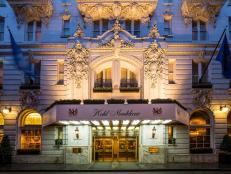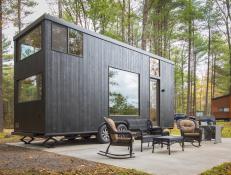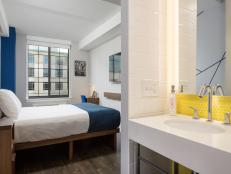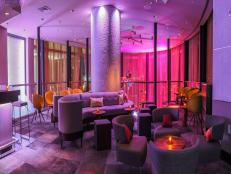Now Is the Time to Visit Martinique
New direct air routes have introduced more Americans to this French secret, home to first-class rum distilleries, beautiful black and white sand beaches and remarkable cultural attractions.
Related To:
lessRelated To:
Magical Martinique
In recent years, direct flights from the Northeast to Martinique on Norwegian Air have made more Americans aware of this overseas region of France in the West Indies, perhaps best known for its rum. But rum isn’t the only reason to visit. Martinique offers shopping in its capital of Fort-de-France, both white and black sand beaches, a tropical botanical garden, a bevy of French and Creole restaurants, watersports and museums. Knowing basic French helps, as the tourism industry is geared toward the majority of visitors who come from France or French-speaking areas. And in many ways Martinique feels like a miniature France in the Caribbean: the currency is the euro, it’s easy to find pain au chocolat (chocolate croissants) and drugstores sell coveted French beauty products. Add Indian, African and Creole backgrounds to the mix, and you’ll find a culture unlike anywhere else. While Norwegian plans on ending U.S. routes as of March 30, Americans can still fly to Martinique via connecting flights in order to experience this French favorite.
Rum Distilleries
As Martinique’s biggest export, the rum that’s produced on the island is unlike anywhere else. That’s because it’s made from sugarcane instead of molasses, earning a rhum agricole (rhum is the French spelling) designation. Many of the rum distilleries started life as sugarcane plantations before switching to rum in the 1800s. Tourists can visit 13 distilleries to sample single estate and aged rums, while also touring the grounds and learning about rum production. Habitation Clément (pictured) is a great place to start as it offers a bit of everything. The expansive botanical grounds are dotted with temporary and permanent sculptures from French and Caribbean artists, along with rare baobab trees that used to populate Martinique. It’s also possible to tour the distillery with an English audio guide, as well as a preserved plantation house, but the highlight is a three-room, contemporary art museum added in 2016 that showcases Caribbean and international artists. A recent exhibition featured mechanical pieces from Swiss artist Jean Tinguely, whose work appears in the Guggenheim. Habitation Clément plans on adding a restaurant in the near future, but it’s still in the planning stages at this point.
Take a Tour
Rhum JM (pictured) is another must-visit distillery, offering an in-depth tour of the production process, from sugarcane machine grinding to fermentation in large vats. It’s noisy and there’s no denying the pungent smell of fermenting rum, but that goes for all distillery tours. It’s worth noting that Rhum JM is one of the few distilleries on Martinique that employs a woman master blender. As it’s located in the northern town of Macouba, just be prepared for the drive on an extremely twisty mountain road. To the southwest, Rhum Depaz can be found in Saint-Pierre, the town destroyed by Mount Pelée in 1902. The eruption also eradicated the former Depaz plantation, which has since been rebuilt. Its lush grounds are populated with sugarcane fields that overlook the water, making it a perfect backdrop for weddings. It’s helpful to take a self-guided tour of the production process (there are English-language signs), before heading to the tasting room to sample vintage rums.
Then there’s Saint James, another distillery with a woman master blender, plus a small museum displaying old magazine ads and production equipment. Not least, Rhum A1710 is Martinique’s newest distillery as of 2016, and differentiates itself from the old guard by only producing white rum. Scheduling an appointment is preferred, and guided tours are offered at 10:30 a.m. every day but Sunday.
Restaurants
Fine French dining, casual Creole fare and a combination of both are what you’ll most commonly encounter in Martinique. Not surprisingly, seafood reigns supreme, with menus offering blue marlin, tuna, crawfish, sea urchin, lambis (conch), crab, dorade and more. Accras, or fritters, are a local favorite and a popular appetizer, no matter the venue. They’re typically stuffed with cod or vegetables, and sometimes served with a Scotch Bonnet pepper. You can find a tasty cod version at Ti Sable (pictured), an upmarket French Creole restaurant with cabana-like tables along Grande Anse d'Arlets beach. Afterward, seven euro will score you a beach lounger and umbrella to nap off lunch.
Colombo is another favorite local dish, made with curry and coconut milk and served with lamb, chicken or pork. It’s available at the beachside legend Le Petibonum, which is just as well known for its chef as for its food. Owner Guy Ferdinand, dubbed Chef Hot Pants thanks to his uniform of short shorts, can usually be found circulating among the tables checking in on diners eating dishes like pumpkin puree with foie gras. Expect a giant chalkboard menu to be brought to your table, and yes, it’s in French. Similar to Ti Sable, there’s the option to rent a lounge chair and umbrella at Le Coin beach, regardless of whether or not you eat at the restaurant.
Seafood Galore + Local Cocktails
Zanzibar Restaurant is a boho fine dining option just across the street from the beach in Le Marin, where Yole boat sailing is offered. Start with a Ti Punch, as it’s considered Martinique’s national cocktail. This is a DIY experience, with the rum and sugarcane syrup served separately, and left to the imbiber to mix in their preferred ratio before adding a squeeze of lime. Spiny lobster, stuffed crab and crawfish are all good bets here, as is the brioche with salted caramel sauce for dessert. But Martinique offers more than beach restaurants. In Fort-de-France you’ll find Le Yellow, a modern French Creole restaurant up a yellow flight of stairs. Homemade bread and risotto with sea urchin and ginger are among the standouts. La Table de Marcel is a newer entry, located in Le Simon Hotel next to the cruise ship terminal, and chef Marcel Ravin holds a Michelin star for Blue Bay in Monaco. And for a casual bite after a long day, Oasis Grill usually has a long line of locals ordering cod fritters, fresh fish, sweet potato fries and thick fruit smoothies. Arrive closer to opening time if you want to snag a table under the tent.
Hotels
As previously mentioned, Le Simon Hotel (pictured) is the first new build in Fort-de-France in 15 years, and design lovers will appreciate the contemporary interiors that favor black-striped floors, yellow accents and bold patterns. Diamant Les Bains first opened in 1945 as the first hotel on Martinique. It’s currently undergoing a complete overhaul, with an anticipated early April 2019 reveal introducing a beachside restaurant, pool and rebuilt rooms. French Coco is a relatively new boutique hotel in Tartane on the Atlantic coast, and as a Small Luxury Hotels of the World member, it feels like staying in your own botanical garden, but with a pool and easy beach access. Le Cap Est Lagoon Resort and Spa is another favorite, a four-star property with a recently renovated beachfront restaurant, curved infinity pool and spacious rooms with private plunge pools.
Beaches
Some of Martinique’s best beaches are found in the southern portion, prime examples of white sandy stretches shaded by swaying palm trees. Even better, all of the public beaches are free. Unless you’re staying at a resort with a beach, plan on renting a stick-shift car in order to experience them. Public transportation is limited, and there’s no Uber or Lyft at the moment. Ferries are a convenient way of getting around, but some beaches can only be accessed by car. Depending on where you’re based, be prepared to deal with traffic, traffic circles and winding mountain roads as you navigate to the likes of the popular Grande Anse d’Arlet or Grande Anse des Salines (pictured) in Saint Anne, along the calmer Caribbean coast. Nearby, snorkelers head to Anse Dufour. Anse Bonneville is a favorite for surfing, along with beaches along the rougher Atlantic side. Kitesurfing is also popular at Atlantic side beaches such as Pointe Faula.
Meanwhile, the north offers black sand beaches like Anse Turin and Anse Couleuvre, resulting from Mount Pelée erupting in 1902. And consider sailing a traditional Yole boat for an only-in-Martinique experience. Yole boats are a revived ancient sailing tradition that requires one person to steer a large oar in the back of the boat, and at least one person to sit on a horizontal oar over the water as a way to turn the boat. You can experience this trip with Beyond the Beach in Le Marin, which includes a beach stop at Club Med Buccaneer’s Creek (the only all-inclusive resort on the island), complete with cod fritters and local Planter’s Punch.
Attractions
Martinique itself is like one big botanical garden — after all, its nickname is Isle of Flowers. You’ll find red ginger gracing restaurant tables, fields of banana and pineapple crops, and every type of tree imaginable throughout the island, not limited to mango, calabash, mimosa, breadfruit, starfruit, papaya and avocado. But just north of Fort-de-France, the Jardin de Balata botanical garden (pictured) is still a tropical wonderland, home to candle cacti, rare balata trees (once used to make golf balls), bromeliads and giant alpinias. You could easily spend a couple hours wandering the grounds, but leave time for traversing the canopy rope bridge in order to snap the best overview photos. Nearby is Balata Cathedral, or Eglise du Sacré Cœur de Balata, built in 1925 to resemble the Sacré-Cœur Basilica in Paris.
Make a Saint-Pierre Stop
The former capital of Saint-Pierre, about an hour north of the current capital of Fort-de-France, is worth spending an afternoon exploring the town and preserved ruins of a jail and 18th-century theater. The now-dormant Mount Pelée erupted in 1902, killing about 30,000 people. One of the only survivors happened to be a prisoner who made it out alive thanks to his well-constructed jail cell, which still stands intact today. Saint-Pierre was partly rebuilt after the eruption, although only 4,000 residents now call it home. Rhum Depaz is just outside the town and makes for a good combination visit. It’s also possible to hike to the 4,583-foot peak of Mount Pelée.
Over on the northeast end of Martinique, near the Saint James Distillery, lies le tombolo de Sainte-Marie (pictured), a narrow spit of land that allows one to walk to the uninhabited Îlet Sainte-Marie during low tide in dry season. Thanks to the direction of the ocean currents, this phenomenon channels the feeling of Moses parting (and crossing) the Red Sea, minus the biblical drama.
Local History in Fort-de-France
You can easily wander the compact capital of Fort-de-France, best enjoyed when large cruise ships aren’t in port. Its ornate balconies lend the city a decidedly New Orleans feel, and its narrow streets are filled with businesses. Among the points of interest are Grand Marche, a covered market selling fresh produce and touristy souvenirs, the 19th-century Schoelcher library and Fort Saint-Louis, a working naval base that reopened for public tours in 2014.
It would be a shame to leave Martinique without visiting La Savane des Esclaves (pictured), a living history museum that recounts the island’s history of slavery. A series of huts depict the harsh realities of plantation life as well as life after slavery was abolished. Another section provides a glimpse into the lives of the indigenous Carib and Arawak inhabitants, and includes an outdoor theater with weekly folk dance performances. English signs allow one to do a self-guided tour.





